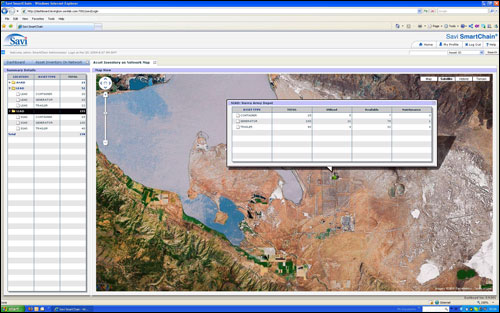Savi Technology has announced it is offering its applications, services and hardware, known collectively as the Savi Developer Tools—including the new RFID system-on-a-chip (SoC) technology—with the goal of making it easier for other companies to create 433 MHz RFID active tags and other products complying with the ISO 18000-7 standard (also known as Dash7).
The move follows other efforts during the past 15 months intended to help promote the adoption and increase the availability of Dash7 RFID hardware to the technology’s primary user—the U.S. military—as well as to a variety of other vertical markets that have not yet deployed Dash7 RFID systems (see Dash7 Alliance Seeks to Promote RFID Hardware Based on ISO 18000-7 Standard, Savi’s New Licensing Program Slashes Costs for ISO 18000-7 and DOD Tests, Buys New ISO 18000-7 Tags From Four Companies).
The program offers developers an entire package of Savi tools, including its Web services, SmartChain software and hardware, such as reader boards and tag modules. In years past, Savi has offered portions of this kit, including software and Internet services, on a limited basis, as needed, says Paul Krakow, the company’s director of business development. However, for the first time, it is now offering the entire set, which is now available. Prices vary according to the services, applications or hardware that a company purchases directly from Savi. “We finally got to the point where we could provide every piece of the entire stack,” he says. “We’ve had a backlog of people wanting to play with our technology, and the numbers have been increasing. By making this kit available, we’re offering an easier way for developers to get started.”
The Developer Tools include Web services hosted by Savi and available on the firm’s Web Services page, which other companies can use to create their own Web applications that connect to the Savi-hosted Web services—such as I-Guides, a software system to help create and manage unique identifiers (UIDs) for equipment produced for the U.S. Department of Defense (DOD).
“A computer vendor could set up its order-processing system to connect with the I-Guides Web service to automatically generate an IUID for any government orders,” Krakow explains. Other Web services offered as part of the Developer Tools program are the Savi Asset Life Cycle Management service and the Shipment Life Cycle Management service, which could be utilized to enable applications that display updates regarding the location of a shipment or asset. These Web services, Krakow says, will be available free to developers through Sept. 30, 2010; following that period, a usage fee may be charged.
The Developer Tools program also includes what are known as “adaptive applications,” which are the five applications included in Savi’s SmartChain suite of software applications designed to transform automated data into actionable information in order to monitor the location, security and condition of assets while in transit or on-site. According to Savi, by employing the SmartChain applications as is, or by building their own customized system off the SmartChain applications, developers can lower the cost of creating an asset-management or supply-chain-management solution. The SmartChain applications consist of the SmartChain Asset Management Application; the Consignment Management Application; Site Manager, for managing an RFID infrastructure at a specific site; Workstation, for day-to-day business operations at the site; and Mobile applications, for handheld reader management.
Finally, the kit comes with Savi RFID hardware components that companies would require to embed active RFID products into their own hardware and software products. That hardware includes a Savi reader board, for those looking to adapt an ISO 18000-7 system to their existing reader technology, or Savi readers themselves, to capture tag ID numbers and forward that information to the SmartChain software.
Savi Technology has also unveiled a new tag module known as an RFID System on a Chip (SoC), Krakow says, which is scheduled for release in fall 2010. The new module is also part of the Developers Tools program, and can be ordered now. The SoC module, which combines all of the primary capabilities of Savi’s other RFID tags and contains an ultra-low-power 32-bit ARM core processing chip, measures 9 millimeters by 9 millimeters (0.4 inch by 0.4 inch).
Years ago, other firms were already working with Savi to integrate an active RFID system into their existing technology, and some of that work has resulted in the kit that is available today. One example is Comtech Mobile Datacom, which manufactures Movement Tracking System (MTS) devices used by the U.S. Army. The MTS units incorporate GPS and satellite telecommunications technologies for military combat service support vehicles carrying cargo, similar to the OnStar system used by civilian vehicles.
In 2004, when the DOD issued a mandate requiring that active RFID tags be placed on many items being shipped overseas, the Army requested that Comtech Mobile Datacom integrate an active RFID reader into its MTS devices, says Eddie Coleman, Comtech’s program manager. This would change the device from a strictly satellite-tracking and communications system for the vehicle to which it was attached, to a solution that could also capture RFID tags within 300 feet of that vehicle, and send those tags’ location information to the Army’s In-transit Visibility Server. There, the data is stored and provided to Army personnel, to help them track their assets’ locations.
After two years of development, during which it worked closely with Savi Technology, Comtech created a system that included the 18000-7 RFID reader built into its existing MTS product, as well as incorporating a military-quality GPS system (which is higher quality than commercial versions). The new RFID-enabled MTS units were put to use by the DOD in summer 2005. To RFID-enable its MTS device, Comtech needed a circuit board that it designed itself (for routing electrical signals from the multiple devices built into the transceiver), as well as a Savi RFID circuit board, one of Savi’s application program interfaces (API) and Savi software to integrate the reader data with Comtech’s own software. Had Comtech had the Developer Tools kit, Coleman says, “We think we would have been able to do that in a third of the time.”
To date, Comtech has fitted more than 25,000 U.S. military vehicles (which now include Humvees) with its RFID-enabled MTS systems. Since 2005, Coleman says, when the company introduced its MTS system with RFID, higher-quality GPS and satellite technologies, the U.S. military’s usage of the MTS RFID readers has grown exponentially—in part, because there are more tags in use, and also because the device’s users in the Armed Forces are getting more comfortable with the technology and, therefore, use it more often.
Savi hosted an RFID Journal webinar on June 30, regarding the new developer’s tools. Since then, Krakow says he’s received follow-up calls from both DOD contractors and other individuals with commercial applications who are interested in utilizing the tools. In the past few years, he notes, the use of RFID has expanded to a variety of vertical markets in which the technology has not previously had a presence. With that in mind, he says, businesses with less experience in RFID technology could benefit from Savi’s offering to develop their own RFID-based systems. “We want companies to take advantage of what we’ve learned, and to leapfrog over the painful getting-it-right stage directly to a profitable solution,” he states. “We want to see this get beyond the traditional space, and make it work for companies that aren’t specialty [RFID] shops.”




